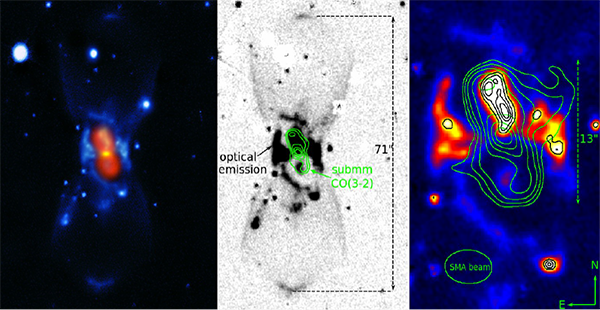Dying Stars:
SMA reveals a molecular remanant of an ancient eruption CK Vul
The eruption of CK Vul was observed in 1670-72 and had been considered to be a nova. Recent (2014-2015) observations, including maps from the SMA, revealed that the remnant of CK Vul is rich in molecules and dust. The mass and isotopic composition of the material seen in the SMA observations exclude the possibility that the 17th century outburst was a classical nova. Instead, it was proposed that CK Vul eruption was a stellar-merger event. Historical records of CK Vul’s outburst describe an object very similar to what is today known as a red nova. Red novae are systems where stars spirall in, collide and eventually merge producing spectacular outbursts which we can observe in real time. After the outburst, red novae cool down to low temeratures and produce a lot of molecules and dust in their circumstellar environment, just as observed in CK Vul. The SMA delivered first inteferometric maps of the molecular gas and dust in this object.

Left: color rendition of optical emission of recombining gas (blue) and submillimeter emission tarced by the SMA in molecular CO gas (orange) and dust continuum radiation (yellow). Middle and left: The green contours show the CO J=3-2 emission as observed with the SMA and background image shows the optical image (from Gemini). Left: Black contours show the optical emission, mainly within a jet emanating toward north from the stellar object hidden in the remnant. It partially ovelaps with the northern molecular lobe.
References:
Kamiński et al.,
Nuclear ashes and outflow in the eruptive star Nova Vul 1670, 2015, Nature 520, 322
Other Resources:
https://www.eso.org/public/usa/news/eso1511/
